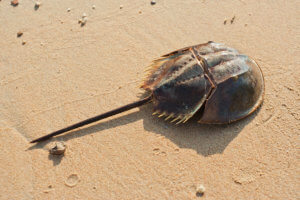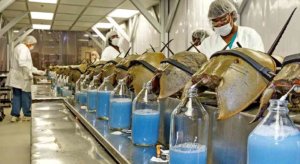04 Sep The Amazing Blue Blood of Horseshoe Crabs
Horseshoe crabs are special creatures with a secret: their unique blue blood. This blood isn’t just pretty to look at; it does an essential job that helps keep people safe. Understanding what horseshoe crabs’ blood is used for reveals a fascinating intersection of nature and modern medicine.
These ancient creatures have been on Earth for over 450 million years, even before dinosaurs. Their ability to survive multiple mass extinctions shows their resilience, but it’s their blue blood that has drawn modern attention.
Despite their simple appearance, horseshoe crabs are important to the medical industry. Their blood helps protect the safety of vaccines, drugs, and medical devices. This blend of ancient biology and modern science highlights how much we depend on nature to advance human health. The unique properties of their blood have transformed how we protect medical products and fight diseases.
What Are Horseshoe Crabs’ Blood Used For?
Unlike most animals with red blood, horseshoe crabs have blue blood. This blood can detect harmful germs that could make humans sick. Because of this, doctors and scientists use their blood to make sure medicines and medical tools are safe.
The blue color comes from copper-based hemocyanin, which carries oxygen. However, the most important part of their blood is a substance called Limulus Amebocyte Lysate (LAL), which is highly sensitive to bacterial toxins. Even tiny amounts of these toxins can be dangerous.
LAL’s unmatched ability to detect contamination has made it the gold standard in the pharmaceutical industry. Every vaccine, intravenous drug, and medical device undergoes LAL testing to make sure they are free from harmful bacteria. This process has saved countless lives by preventing infections and shows how much we rely on nature’s remarkable systems in healthcare.
How Horseshoe Crab Blood Works
Inside their blue blood, horseshoe crabs have a powerful part called LAL. For the crab, LAL acts like a superhero. If any harmful germs enter their body, the LAL spots them immediately. Then, it clots around these germs, capturing them and preventing them from spreading and causing harm.
For humans, this ability is a game-changer. Scientists noticed how the LAL can detect even the tiniest amounts of dangerous germs. So, they began using horseshoe crab blood to test if medicines, vaccines, and even some medical tools are free from harmful germs to make sure they’re safe for us to use.
This detection process is vital in the production of vaccines, especially those intended for widespread use, such as the COVID-19 vaccines. During the pandemic, the ability to quickly and accurately test vaccines for bacterial contamination became more important than ever. The reliance on LAL played a significant role in the global vaccination effort.
The Challenges They Face
While their blood is very valuable, it has put the horseshoe crabs in danger. Taking their blood is a tricky process. Fishermen catch the crabs and transport them to labs where scientists remove their blood. Once the blood has been removed, the crabs are transported back to the ocean. However, this may hurt the crabs. In fact, many crabs don’t survive after this.
It’s even more challenging for the crabs in some areas, like Asia. There, after scientists take their blood, the crabs are eaten instead of being returned to their homes in the water. Fishermen also use horseshoe crabs for bait. Additionally, their habitats are disappearing, and birds eat their eggs. Because of these issues, we might see fewer and fewer horseshoe crabs in the future.
These practices affect more than just the horseshoe crabs. They are important to their ecosystems, especially in supporting other species. Their eggs provide food for migratory birds, and their presence helps keep coastal environments healthy. A decline in horseshoe crabs threatens not only the crabs but also the larger ecosystems they support.
Will Horseshoe Crabs Go Extinct?
The American horseshoe crab is listed as vulnerable on the IUCN Red List of Threatened Species. This means they’re at risk, but rules are in place to help keep them safe. Thanks to these efforts, some crab populations are growing, though others are still in danger.
In Asia, the situation is not as hopeful. One of Asia’s native species is already classified as endangered and has disappeared from places like Taiwan. It might also disappear from other regions like Hong Kong soon. The other two species in Asia are also in danger.
The decline of horseshoe crabs in Asia is particularly concerning because of the rapid development and industrialization of coastal regions, which has led to habitat destruction. Additionally, the practice of using horseshoe crabs as food and bait further exacerbates the problem. Conservation efforts in these regions have been less successful. Without significant changes, these species could face extinction.
The Ecological Importance of Horseshoe Crabs
Beyond their medical contributions, horseshoe crabs play a vital role in the ecosystems they inhabit. Their eggs are a food source for migratory birds, especially the red knot, a species that relies on horseshoe crab eggs during its long journey from South America to the Arctic. The decline in horseshoe crab populations has a direct impact on these bird species. This highlights the broader ecological consequences of losing this ancient creature.
Moreover, horseshoe crabs contribute to the health of coastal environments. Their large, hard shells provide a habitat for various marine organisms, including sponges, crabs, and small fish. By maintaining the balance of coastal ecosystems, horseshoe crabs help support biodiversity and the overall health of marine habitats.
Finding Better Ways to Help
Though horseshoe crabs are at risk, there is hope. Some companies are now making a synthetic version of their blue blood to protect the crabs. This allows us to make sure medicines are safe without using real crab blood. While this synthetic version isn’t widely used yet, it could save many crabs in the future.
The synthetic alternative is called Recombinant Factor C (rFC). It is made in labs and works like the real thing without needing horseshoe crab blood. Some companies have started using rFC, and it’s approved in several countries. However, adoption has been slow in areas where traditional methods are still common.
The future of horseshoe crabs and medical testing may depend on the wider use of rFC. As more companies focus on sustainable practices, we can reduce the need for real horseshoe crab blood while keeping medical products safe. Balancing human health with conservation is challenging, but innovation offers a solution.
At Phlebotomy Training Specialists, we understand the critical role that natural and synthetic resources play in the field of medicine. Just as the blue blood of horseshoe crabs has safeguarded human health for decades, our commitment to providing top-tier phlebotomy training makes sure that future healthcare professionals are well-equipped to contribute to the medical field.
Horseshoe crabs are amazing animals with life-saving blue blood. But they face dangers because of it. It’s up to us to find ways to keep both people and crabs safe.



